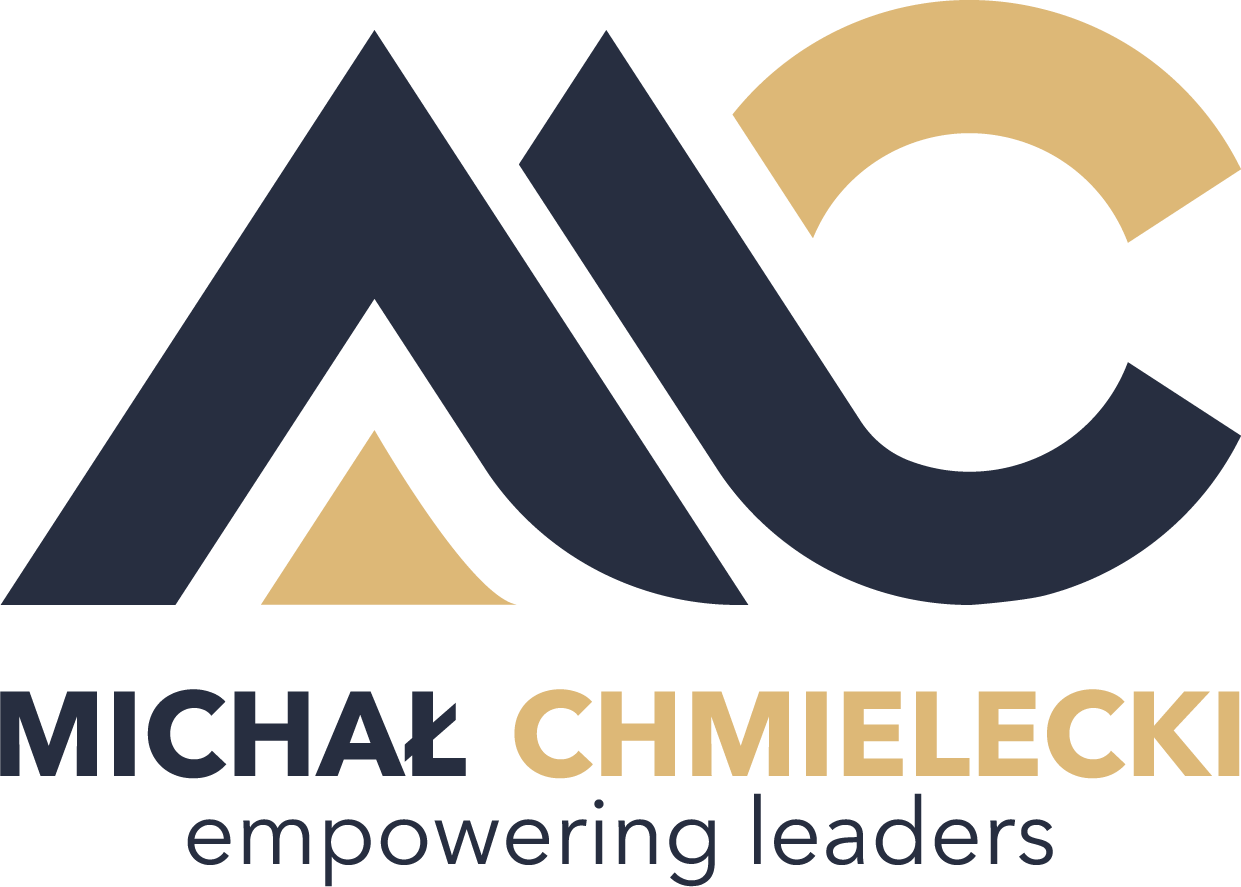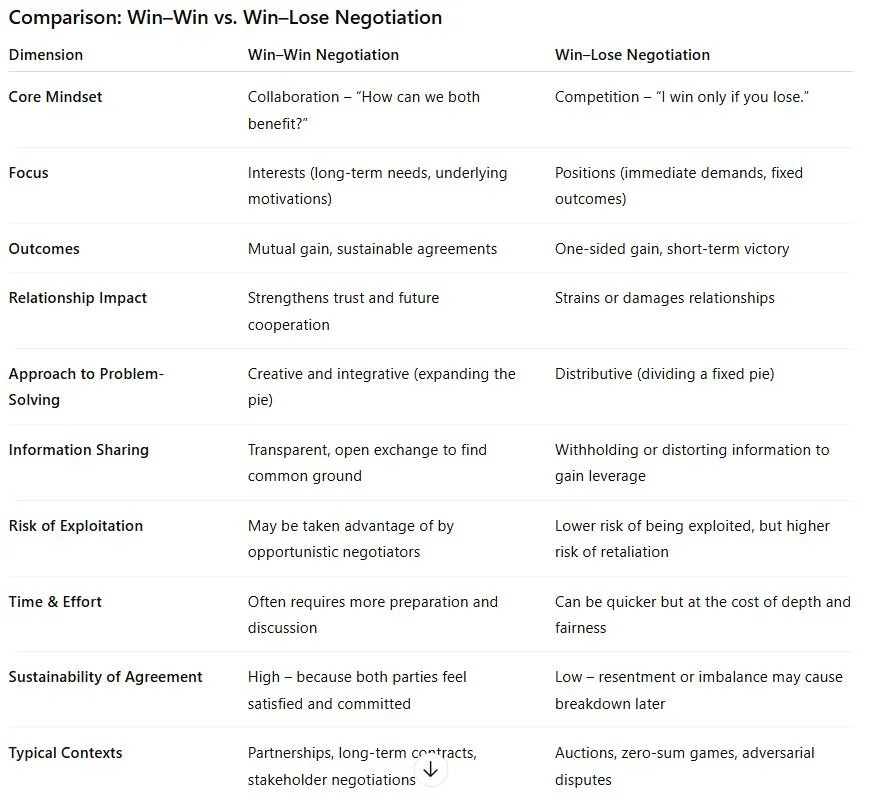Win-win negotiation
Negotiating can be tricky, but win-win negotiation offers an effective strategy for both parties to get what they want. Win-win negotiation is based on the idea that both parties should come away with something beneficial from the agreement, rather than one party taking all the advantages.
This article will explore how to use win-win negotiation tactics to reach mutually beneficial agreements.
What is a win-win negotiation?
Win-win negotiation, also known as mutual gains bargaining, is a strategy where both parties come away with something positive from the agreement. This type of Negotiation seeks to create an outcome where all parties are better off than before the negotiations began. It differs from traditional win-lose or zero-sum approaches in that there is no clear winner or loser; each party has something to gain.
This type of negotiation requires strong communication skills and active listening on both sides so that everyone can understand each other's needs and interests. It also requires trust between the two parties since it involves seeking mutually beneficial solutions rather than winning at the expense of the other. Ultimately, win-win negotiation strives to maximize value for all involved while minimizing conflict and negative feelings associated with traditional win-lose strategies.
Benefits of win-win negotiation
The primary benefit of using a win-win approach to negotiations is that both sides feel satisfied with their agreements since they have achieved some success without sacrificing too much in return. This creates an atmosphere conducive to future cooperation between the two parties and maintaining good relationships overall. Additionally, this kind of negotiation helps reduce tension by allowing participants to focus on finding common ground rather than trying to prove who's right or wrong—which often leads nowhere fast! Finally, this approach will enable participants to devote more time and energy to finding creative solutions since they don't need to worry about "winning" every point or getting angry over disagreements because everyone wants what's best for everyone involved in the result—a true signifier that all went well during negotiations!
How to implement win-win negotiations
The most crucial part of successful implementation is understanding your counterpart's goals. You must explore their potential objectives without making them feel uncomfortable or like you're trying too hard (for example, by asking probing questions). Once these goals are determined, it will become easier for you to determine how your interests might match theirs, thus creating room for further collaboration instead of confrontation during discussions. Here are a few key steps necessary when engaging in this process:
1) Determine Your Goals and Interests
Before starting any discussion, identify your wishes and needs, including what exactly you want to achieve through the talks. What should be non-negotiable versus negotiable items? Determining these ahead of time helps ensure smoother conversations later down the line when tough decisions start being made. Having a general idea of what outcomes would satisfy you makes it easier to reach a compromise quickly if needed while remaining comfortable knowing personal boundaries weren't crossed.
2) Listen Actively and Understand the other side.
You won't get far if you only focus on your own position! The most important thing to do here is spend quality time truly understanding the other side's views: ask questions, clarify points, restate what they've said, confirm understanding, and encourage them to express themselves freely without feeling threatened or judged. This helps build trust between both parties and creates an atmosphere where genuine conversations occur instead of simply debating back and forth over the same topic repeatedly.
3) Focus on Interests, Not Positions
When trying to reach a win-win solution, it's important to remember that each side has different interests at heart; one party may be more focused on reducing costs, while another could prioritize quality product delivery time, etc. As such, rather than getting stuck in positions, try exploring the underlying issues, which often leads to better solutions for all involved!
4) Brainstorming ideas
Now that we understand each other's goals and interests, it's time to develop creative solutions that could work for everyone. Brainstorming involves generating ideas from a combined group of thinkers; no idea is too small or wild to be considered. You never know what type of innovative outcome might arise due to collaboration!
5) Compromise and Negotiate
After the brainstorming session is complete, the actual negotiating process begins, where two sides come together to discuss possible compromises and ensure that all needs are met before a final agreement is reached. During this stage, both parties must remain flexible and open-minded to ensure a fair deal is made in the end. It is helpful and valuable to have a third-party mediator present to assist negotiations if needed since they can provide impartial advice and help guide talks toward resolution quickly and efficiently without bias on either side (if applicable).
Benefits of win-win negotiation
The primary benefit of using a win-win approach to negotiations is that both sides feel satisfied with their agreements since they have achieved some success without sacrificing too much in return. This creates an atmosphere conducive to future cooperation between the two parties and maintaining good relationships overall. Additionally, this kind of Negotiation helps reduce tension by allowing participants to focus on finding common ground rather than trying to prove who's right or wrong—which often leads nowhere fast! Finally, this approach allows participants to devote more time and energy to finding creative solutions since they don't need to worry about "winning" every point or getting angry over disagreements because everyone wants what's best for everyone involved in the result—a true signifier that all went well during negotiations!
Crafting Win-Win Contracts: Key Elements to Include
When it comes to business agreements, it is crucial to create contracts that are not only legally binding but also beneficial to all parties involved. One such approach is to craft win-win contracts that prioritize mutual success and collaboration.
By implementing key elements into these contracts, businesses can foster healthy working relationships, mitigate conflicts, and maximize their long-term potential. In this article, we will discuss the essential components that every win-win contract should incorporate.
1. Clear and Detailed Scope of Work
The first element of a win-win contract is a precise and comprehensive scope of work. Clearly outline the expectations, deliverables, timelines, and key milestones. This ensures that both parties have a shared understanding of the project or service requirements, leaving no room for ambiguity or miscommunication. By setting out a clear scope, you establish a solid foundation upon which collaborative efforts can be built.
2. Balanced Risk Allocation
A win-win contract carefully considers risk allocation. Instead of burdening one party with excessive responsibility, equitable risk sharing fosters a sense of fairness and promotes collaboration. Analyze the risks associated with the project and distribute them in a way that leverages the strengths of both parties. This collaborative approach motivates all parties to work together towards finding solutions and mitigating potential issues.
3. Performance Measurements and Metrics
Another important aspect of a win-win contract is the inclusion of performance measurements and metrics. Establishing key performance indicators (KPIs) allows both parties to monitor progress, evaluate success, and identify areas for improvement. By setting these benchmarks, you ensure transparency, accountability, and an opportunity to assess the effectiveness of the collaboration. Regularly reviewing and adjusting KPIs enhances the chances of achieving shared goals.
4. Flexibility and Adaptability
A win-win contract recognizes the need for flexibility and adaptability in the ever-evolving business landscape. Include provisions that allow for adjustments to the contract, taking into account changes in circumstances, external factors, or unforeseen events. By demonstrating a willingness to adapt, both parties can navigate challenges together, fostering a collaborative and problem-solving mindset.
5. Dispute Resolution Mechanism
Even in the most harmonious collaborations, disputes can arise. To ensure a win-win approach, it is vital to incorporate an effective dispute resolution mechanism into the contract. This can range from mediation to arbitration, depending on the nature and complexity of potential disputes. By establishing a fair and neutral process for conflict resolution, the contract encourages parties to resolve issues amicably, thereby preserving the mutual benefits of the partnership.
Competencies of win–win negotiators
Win–win negotiators consistently demonstrate a set of competencies that allow them to create sustainable agreements built on trust, fairness, and mutual value. These core competencies include:
Emotional Intelligence – They regulate their own emotions, show empathy toward others, and recognize the underlying drivers of behavior, enabling constructive dialogue even under pressure.
Active Listening – They listen not just to respond but to understand, clarifying needs and reframing statements to uncover true interests beyond stated positions.
Strategic Preparation – They enter negotiations with a thorough grasp of facts, priorities, and alternatives, while also researching the counterpart’s perspective to identify areas of alignment.
Problem-Solving Orientation – They focus on generating creative options that expand the pie rather than fighting over limited resources, aiming for outcomes that satisfy all stakeholders.
Communication Clarity – They express ideas clearly, assertively, and respectfully, ensuring transparency and minimizing misunderstandings.
Integrity and Fairness – They uphold ethical standards, avoid manipulative tactics, and build credibility by honoring commitments.
Flexibility and Adaptability – They adjust their approach as the negotiation evolves, balancing firmness on principles with openness to new solutions.
Collaboration Skills – They build rapport, foster trust, and encourage joint ownership of outcomes, leading to agreements that are more durable and self-enforcing.
Conflict Management – They manage differences constructively, de-escalating tensions and redirecting energy toward common ground.
Long-Term Orientation – They view negotiations not as isolated events but as opportunities to strengthen relationships, ensuring continued cooperation and goodwill.
Risks of win–win negotiation
Although the win–win approach aims to achieve mutual value, it is not without potential drawbacks. Overemphasis on collaboration can introduce several risks:
Over-Compromise
Negotiators may give up too much in the pursuit of harmony, leading to outcomes that weaken their own position or fail to protect essential interests.Manipulation by the Other Party
A counterpart with a win–lose mindset may exploit the cooperative stance of a win–win negotiator, securing disproportionate benefits while giving little in return.Time and Complexity
Striving for joint gains often requires prolonged discussion, creative problem-solving, and multiple iterations. This can make negotiations inefficient when speed is critical.Dilution of Accountability
In trying to satisfy everyone, the agreement may become vague or overloaded with concessions, reducing clarity on responsibilities and weakening enforceability.False Equilibrium
An apparent win–win deal may mask hidden dissatisfaction if one side feels pressured into agreement for the sake of maintaining goodwill, risking future conflict.Neglect of Power Dynamics
Focusing too much on collaboration can obscure real differences in leverage, leaving the stronger party dominant despite a “win–win” label.Relationship Over Results
Some negotiators prioritize maintaining relationships over achieving substantive outcomes, which can result in agreements that are friendly but strategically unsound.
Comparison of win–win vs. win–lose negotiation
In conclusion, win-win negotiation offers an effective strategy for reaching mutually beneficial agreements.
Following the steps outlined above, you can maximize value for yourself and your counterpart while minimizing conflict and negative feelings associated with traditional win-lose strategies. Remember: successful Negotiation requires strong communication skills and active listening so everyone understands each other's needs and interests; trust between the two parties; focusing on interests, not positions; brainstorming ideas; compromising when necessary; and finally, having a good attitude throughout the process! With some practice and patience, you can use win-win negotiation tactics to reach agreements that help both sides feel satisfied.
Author: dr Michał Chmielecki, MSc - Negotiation coach and consultant, author of 4 bestselling books



